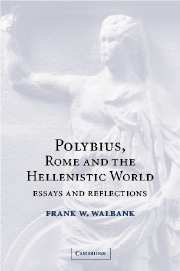Book contents
- Frontmatter
- Contents
- Preface
- Acknowledgements
- List of abbreviations
- 1 Polybian studies, c. 1975–2000
- HISTORICAL AND GEOGRAPHICAL PAPERS
- 2 The geography of Polybius
- 3 Egypt in Polybius
- 4 The surrender of the Egyptian rebels in the Nile delta (Polyb. xxii.17.1–7)
- 5 Two Hellenistic processions: a matter of self-definition
- 6 Polybius and Macedonia
- 7 Sea-power and the Antigonids
- 8 H TΩN OΛΩN EΛΠΙΣ and the Antigonids
- 9 Hellenes and Achaeans: ‘Greek nationality’ revisited
- 10 The Achaean assemblies
- POLYBIUS AS A HISTORIAN
- POLYBIUS ON ROME
- TRANSMISSION OF POLYBIUS
- Bibliography
- Indexes
10 - The Achaean assemblies
Published online by Cambridge University Press: 22 September 2009
- Frontmatter
- Contents
- Preface
- Acknowledgements
- List of abbreviations
- 1 Polybian studies, c. 1975–2000
- HISTORICAL AND GEOGRAPHICAL PAPERS
- 2 The geography of Polybius
- 3 Egypt in Polybius
- 4 The surrender of the Egyptian rebels in the Nile delta (Polyb. xxii.17.1–7)
- 5 Two Hellenistic processions: a matter of self-definition
- 6 Polybius and Macedonia
- 7 Sea-power and the Antigonids
- 8 H TΩN OΛΩN EΛΠΙΣ and the Antigonids
- 9 Hellenes and Achaeans: ‘Greek nationality’ revisited
- 10 The Achaean assemblies
- POLYBIUS AS A HISTORIAN
- POLYBIUS ON ROME
- TRANSMISSION OF POLYBIUS
- Bibliography
- Indexes
Summary
Since the Achaean meetings recorded in xxix.23–5 are among the most important evidence for the character of the Achaean assemblies in the second century, this is an appropriate place to review recent work on this much-discussed problem. The basic studies are now Aymard (1938a) and Larsen (1955) 165–88. Larsen challenged Aymard's view that the synodos was a primary assembly, arguing that, from a date towards the end of the third century, the Achaean assembly ceased to have regular meetings and only came together when, according to carefully defined rules, a special meeting of the primary assembly was called; the four annual synodoi were meetings of the council (boule) together with the magistrates. Larsen reaffirmed this view in Larsen (1972), replying to A. Giovannini, who had argued || that the synodoi continued to be meetings of the primary assembly (along with the Council and magistrates) down to the dissolution of the Confederacy. In a reply to Giovannini I raised some objections and stated that Larsen's theory ‘still seems to me the most convincing’, though ‘no theory yet put forward solves every difficulty to everyone's satisfaction’. Further concern with the problem, encouraged by discussion with G. T. Griffith, has since led me to a different conclusion, and one nearer to Giovannini's, though his account is, in my opinion, partly vitiated by his unwillingness to distinguish adequately between synodoi and syncletoi.
Larsen's theory accounts for much of the evidence, but leaves some serious difficulties.
- Type
- Chapter
- Information
- Polybius, Rome and the Hellenistic WorldEssays and Reflections, pp. 153 - 162Publisher: Cambridge University PressPrint publication year: 2002
- 2
- Cited by

